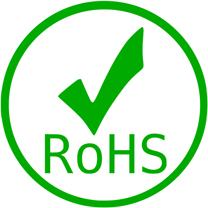ROHS
Information and Services for RoHS

RoHS Directive: Limiting Hazardous Substances in Electrical and Electronic Equipment
RoHS Information and Services for RoHS Directive
The RoHS Directive of the European Union, short for “Restriction of the use of certain hazardous substances in electrical and electronic equipment,” aims to limit the use of certain hazardous substances in electrical and electronic devices. The main goal of this directive is to protect human health and the environment by reducing pollutants and promoting better recycling practices. It includes regulations to restrict substances such as lead, mercury, and cadmium.
Since its introduction, the RoHS Directive has been revised multiple times. The current version of the European Directive 2011/65/EU, including all annexes, is available for reference.
In Germany, the RoHS Directive has been incorporated into national law through the Ordinance on the Restriction of Hazardous Substances in Electrical and Electronic Equipment (ElektroStoffV). In Austria, the requirements have been regulated since 2005 under the Electrical and Electronic Waste Ordinance. Many non-EU countries, including Switzerland and Liechtenstein with the Chemicals Risk Reduction Ordinance, as well as China (China-RoHS) and South Korea (Korea-RoHS), have introduced similar regulations.
Who is Affected by the RoHS Directive?
The RoHS Directive primarily affects manufacturers and importers of electrical and electronic equipment within the European Union. It was introduced to reduce the use of particularly dangerous substances in these devices, which can harm both the environment and human health. Problematic substances restricted by the directive include lead, mercury, cadmium, hexavalent chromium, and brominated compounds such as polybrominated biphenyls (PBB) and polybrominated diphenyl ethers (PBDE). These substances may only be present in products in very small amounts, with a limit of 0.1 percent by weight.

Restrictions and Bans under the RoHS Directive
The RoHS Directive not only bans the use of certain hazardous substances but also restricts certain manufacturing processes. For example, the use of lead-containing solder in electronics manufacturing and the use of toxic flame retardants in cable production are prohibited. These regulations affect not only importers and companies along supply chains but also consumers in the European Economic Area who experience the direct impact of the directive.
Many previously used manufacturing processes and materials are no longer permitted due to these provisions. However, there are exceptions, where certain substances may still be used under specific conditions.
Challenges and Exceptions under the RoHS Directive
For industries such as the automotive sector, using lead-free solder is particularly challenging. Switching to alternative silver-based solders is not only associated with higher costs but also introduces quality difficulties for manufacturers. Due to these challenges, there are several exceptions to the RoHS Directive, especially in the medical, military, and vehicle electronics sectors.
One such exception is the continued allowance of lead in starter batteries for motor vehicles. Lead can also be present in copper alloys up to a weight percentage of 4%. These exceptions are, however, subject to regular reviews and may be adjusted or revoked in the future.
Another aspect of the RoHS Directive is that substance bans can be enacted without a full “risk assessment” for alternative substances. It is sufficient if there is a potential risk to human health and the environment to enforce a ban.
The implementation of the RoHS Directive is further complicated by national special regulations, as they are not uniformly applied across the EU. For example, in the Netherlands, car radios sold in retail fall under the directive, whereas in other countries, this exception does not apply. Such differing regulations pose significant challenges for developers, especially when their products are offered in multiple EU countries. They must regularly account for new exceptions, with the approval of exemption requests often taking several years.
Substances Restricted by the RoHS Directive
The RoHS Directive sets restrictions for the following ten substances. The maximum permissible concentration in homogeneous materials is given in weight percent:
• Lead (0.1%)
• Mercury (0.1%)
• Cadmium (0.01%)
• Hexavalent chromium (0.1%)
• Polybrominated biphenyls (PBB) (0.1%)
• Polybrominated diphenyl ethers (PBDE) (0.1%)
• Di(2-ethylhexyl)phthalate (DEHP) (0.1%)
• Butylbenzylphthalate (BBP) (0.1%)
• Dibutylphthalate (DBP) (0.1%)
• Diisobutylphthalate (DIBP) (0.1%)
However, there are exceptions to these limits, as outlined in Annex III of Directive 2015/863/EU. This annex is updated every four years.
Impact of the RoHS Directive on Your Business
The RoHS Directive affects all European companies that manufacture certain devices or produce parts for them. According to Annex I, this includes the following categories:
• Large household appliances
• Small household appliances
• IT and telecommunications equipment
• Consumer electronics
• Lighting equipment
• Electrical and electronic tools
• Toys and leisure and sports equipment
• Medical devices
• Monitoring and control instruments, including in industry
• Automatic dispensing machines
• Other electrical and electronic equipment not falling into the categories above
Since 2011, manufacturers are also required to issue an EU Declaration of Conformity, affix the CE marking on the devices, ensure ongoing conformity, and meet certain documentation and information obligations.
Our RoHS Services
We offer independent and objective advice on RoHS and REACH. Our interdisciplinary expert team is well-versed in industry-specific special regulations. Take advantage of our extensive expertise in RoHS and REACH – schedule a free needs assessment today!
- RoHS 3 expands the list of restricted substances. We support you in analyzing your products and preparing the required documentation.
Additional Promotional Texts with Different Focuses:
• Safety and Trust: “Ensure your products meet the highest environmental standards. We make your RoHS compliance a breeze.”
• Cost Savings: “Avoid hefty fines and protect your reputation. Our experts help you optimize the costs of RoHS compliance.”
• Comprehensive Solutions: “From analysis to certification: We provide a complete solution for your RoHS compliance.”
• Tailored Consultation: “Your products are unique – so are our solutions. We tailor our consultation to your specific requirements.”
Free Consultation, Keywords such as “RoHS 3,” “Material Compliance,” “Hazardous Substances,” “Electrical Equipment,” “Compliance Consulting.” Testimonials: Add positive customerreviews.
